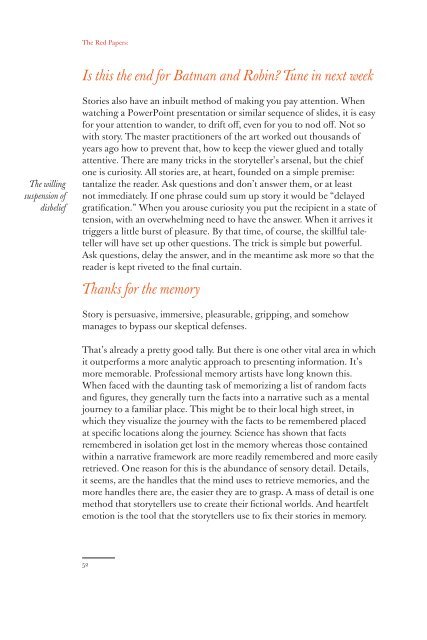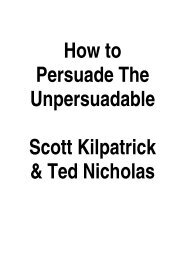1rZwMNa
1rZwMNa
1rZwMNa
You also want an ePaper? Increase the reach of your titles
YUMPU automatically turns print PDFs into web optimized ePapers that Google loves.
The Red Papers:<br />
Is this the end for Batman and Robin? Tune in next week<br />
The willing<br />
suspension of<br />
disbelief<br />
Stories also have an inbuilt method of making you pay attention. When<br />
watching a PowerPoint presentation or similar sequence of slides, it is easy<br />
for your attention to wander, to drift off, even for you to nod off. Not so<br />
with story. The master practitioners of the art worked out thousands of<br />
years ago how to prevent that, how to keep the viewer glued and totally<br />
attentive. There are many tricks in the storyteller’s arsenal, but the chief<br />
one is curiosity. All stories are, at heart, founded on a simple premise:<br />
tantalize the reader. Ask questions and don’t answer them, or at least<br />
not immediately. If one phrase could sum up story it would be “delayed<br />
gratification.” When you arouse curiosity you put the recipient in a state of<br />
tension, with an overwhelming need to have the answer. When it arrives it<br />
triggers a little burst of pleasure. By that time, of course, the skillful taleteller<br />
will have set up other questions. The trick is simple but powerful.<br />
Ask questions, delay the answer, and in the meantime ask more so that the<br />
reader is kept riveted to the final curtain.<br />
Thanks for the memory<br />
Story is persuasive, immersive, pleasurable, gripping, and somehow<br />
manages to bypass our skeptical defenses.<br />
That’s already a pretty good tally. But there is one other vital area in which<br />
it outperforms a more analytic approach to presenting information. It’s<br />
more memorable. Professional memory artists have long known this.<br />
When faced with the daunting task of memorizing a list of random facts<br />
and figures, they generally turn the facts into a narrative such as a mental<br />
journey to a familiar place. This might be to their local high street, in<br />
which they visualize the journey with the facts to be remembered placed<br />
at specific locations along the journey. Science has shown that facts<br />
remembered in isolation get lost in the memory whereas those contained<br />
within a narrative framework are more readily remembered and more easily<br />
retrieved. One reason for this is the abundance of sensory detail. Details,<br />
it seems, are the handles that the mind uses to retrieve memories, and the<br />
more handles there are, the easier they are to grasp. A mass of detail is one<br />
method that storytellers use to create their fictional worlds. And heartfelt<br />
emotion is the tool that the storytellers use to fix their stories in memory.






